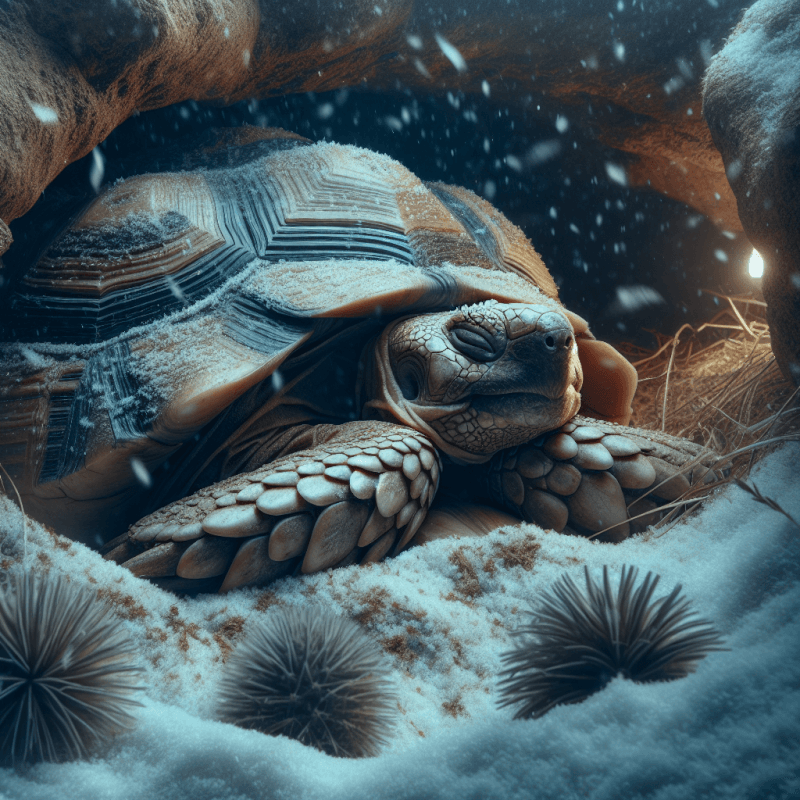Have you ever wondered if it’s normal for reptiles to hibernate? Well, the answer might surprise you. While many people associate hibernation with mammals, some reptiles actually do go through a similar period of dormancy. From snakes to turtles, certain species of reptiles have been known to enter a state of hibernation during the colder months. In this article, we will explore the reasons behind reptile hibernation and discover how it differs from mammalian hibernation. So, let’s unlock the secrets of reptilian slumber and uncover the fascinating world of reptile hibernation together.

What is hibernation?
Definition
Hibernation is a state of dormancy that certain animals, including reptiles, enter during the winter months. It is characterized by a significant reduction in metabolic activity, prolonged periods of inactivity, and a decrease in body temperature.
Purpose
The primary purpose of hibernation in reptiles is to conserve energy during periods of unfavorable environmental conditions, such as cold weather or limited food availability. By slowing down their bodily functions, reptiles can survive without actively seeking out resources and reduce their overall energy expenditure.
Common characteristics
Reptiles that hibernate share certain common characteristics during this period. They typically seek out a protected and sheltered location, such as underground burrows, rock crevices, or tree hollows. Their metabolism slows down significantly, resulting in reduced heart rate and breathing. Additionally, reptiles may experience dehydration as their water intake decreases during hibernation.
Reptile behavior in winter
Types of reptiles that hibernate
Several reptile species are known to hibernate. Common examples include turtles, snakes, and some lizard species. While not all reptiles hibernate, those that do have adapted to survive in environments with drastic changes in temperature and food availability.
Triggers for reptile hibernation
Reptiles rely on environmental cues to initiate hibernation. The primary trigger is typically a decrease in ambient temperature. As temperatures drop, reptiles sense the change in their surroundings and begin their preparation for hibernation. Other factors such as reduced daylight hours and food scarcity may also influence reptile behavior during winter.
Hibernation duration
The duration of reptile hibernation varies among species. It can range from a few weeks to several months, depending on the reptile’s natural habitat and the severity of the winter conditions. Some reptiles, like box turtles, may enter a state of semi-hibernation known as “brumation,” where they periodically emerge from their hibernation state during milder winter periods.
Physiological changes during reptile hibernation
Slow metabolism
During hibernation, a reptile’s metabolism slows down significantly. This decrease in metabolic activity helps conserve energy and allows reptiles to cope with limited food availability. By reducing their energy requirements, reptiles can survive for an extended period of time without having to actively hunt for food.
Reduced heart rate and breathing
Reptiles that hibernate experience a significant reduction in heart rate and breathing rate. This adaptation helps lower their overall energy expenditure and ensures their survival during periods of reduced activity. It also enables reptiles to tolerate low oxygen levels in their hibernation environment.
Dehydration
Reptiles in hibernation can experience dehydration due to the decreased water intake during this period. To compensate for the lack of water, hibernating reptiles may rely on moisture stored in their tissues. This ability to tolerate dehydration is an important adaptation that allows them to survive in arid environments with limited water sources.
Benefits of reptile hibernation
Conservation of energy
One of the significant benefits of reptile hibernation is the conservation of energy. By entering a state of reduced metabolic activity, reptiles can significantly decrease their energy expenditure during periods of low food availability. This conservation of energy allows them to survive until more favorable conditions return, such as the arrival of spring with its abundance of food.
Protection from harsh conditions
Hibernation provides reptiles with protection from harsh winter conditions. By seeking shelter in underground burrows or other protected locations, reptiles can avoid extreme temperature fluctuations, freezing temperatures, and harsh weather elements. Hibernation allows them to wait out the challenging conditions until more favorable environmental conditions return.
Increased lifespan
Reptile hibernation has been linked to increased lifespan in some species. The reduced metabolic activity and slower aging process during hibernation contribute to a longer lifespan for hibernating reptiles. Additionally, the conservation of energy and reduced exposure to predators or other risks during hibernation further enhance their chances of survival and longevity.

Factors affecting reptile hibernation
Species-specific requirements
Different reptile species have specific requirements for hibernation. These requirements include temperature ranges, humidity levels, and specific hibernation locations. Some reptiles, like certain turtle species, require an aquatic hibernation environment, while others prefer dry and well-protected locations. Understanding the unique hibernation needs of each species is crucial for their successful hibernation.
Environmental cues
Environmental cues play a vital role in triggering reptile hibernation. Changes in temperature, daylight hours, and food availability signal to reptiles that it is time to prepare for hibernation. Reptiles are highly attuned to these cues and rely on them to enter and exit hibernation. Disruptions or alterations in these environmental cues can impact the hibernation cycle and potentially affect the reptile’s health and survival.
Health and age
The health and age of a reptile can influence its ability to hibernate successfully. Healthy reptiles with robust immune systems and adequate fat reserves are more likely to enter and exit hibernation safely. Young or weak reptiles may struggle to withstand hibernation’s physiological stress and may require special care or monitoring to ensure their well-being.
Differences between reptile hibernation and brumation
Definition of brumation
Brumation is a state of dormancy similar to hibernation but differs in certain aspects. While hibernation is triggered by cold temperatures, brumation is more influenced by decreasing daylight hours and food availability. Brumating reptiles may exhibit reduced activity and enter a state of lowered metabolic rate, but they may periodically awaken and move around during milder winter periods.
Dissimilarities in metabolic activity
In hibernation, reptiles experience a significant decrease in metabolic activity, including heart rate and breathing rate. In contrast, reptiles in brumation still maintain some metabolic activity, though at a reduced level. Brumating reptiles may occasionally emerge from their state of lowered metabolic rate to bask or search for food before returning to their dormant state.
Behavioral variations
Behaviorally, hibernating reptiles are typically less active and may appear sluggish or immobile. They often seek shelter and remain in a relatively fixed position for the duration of their hibernation. Brumating reptiles, while exhibiting reduced activity, may occasionally move around, explore their surroundings, or even engage in limited feeding.

Preparation for reptile hibernation
Food intake and digestion
Before entering hibernation, reptiles typically increase their food intake to build up fat stores. This increased consumption ensures they have enough energy reserves to sustain them through the period of reduced feeding. Additionally, reptiles may continue to digest their last meal before entering hibernation, as the digestive process slows down during dormancy.
Seeking shelter
Reptiles actively seek out suitable hibernation locations before entering dormancy. They may burrow into the ground, find natural crevices in rocks or trees, or utilize man-made structures like tunnels or boxes specifically designed for hibernation. These sheltered locations protect them from extreme temperatures, predators, and other potential dangers.
Body condition evaluation
Assessing a reptile’s body condition is crucial before hibernation. Reptiles should be in good health, with adequate fat reserves, to withstand the physiological stress of hibernation successfully. Poor body condition or underlying health issues may indicate a need for veterinary assessment or alternative care measures to ensure the reptile’s well-being during hibernation.
Hibernation myths and misconceptions
Hibernation location
Contrary to popular belief, not all reptiles hibernate underground. While many reptiles prefer burrows or underground shelters, others may choose tree hollows, rock crevices, or even man-made structures for their hibernation. The specific hibernation location depends on the reptile species and its unique habitat requirements.
Hibernation depth
The depth of hibernation varies among reptiles. Some reptiles may burrow deep into the ground, seeking greater temperature stability and protection from external influences. Others may hibernate closer to the surface or even remain aboveground in well-insulated locations. The hibernation depth depends on factors such as the reptile species, ambient temperatures, and available hibernation options.
Movement during hibernation
Hibernating reptiles generally display minimal movement or activity. While slight movements or adjustments in position may occur, reptiles in hibernation primarily remain still to conserve energy. They conserve their resources by minimizing unnecessary movement and staying in a relatively fixed position until suitable environmental conditions prompt their reemergence.

Risks and concerns associated with reptile hibernation
Inadequate preparation
Inadequate preparation for reptile hibernation can lead to various risks and concerns. Lack of sufficient fat reserves, improper shelter, or incorrect temperature and humidity conditions can negatively impact the reptile’s health or result in unsuccessful hibernation. It is crucial to thoroughly research and understand the specific hibernation requirements of each reptile species to ensure their well-being.
Health complications
Hibernation poses certain health risks for reptiles, especially those with underlying health issues. Conditions such as respiratory infections, parasites, or other illnesses can worsen during hibernation, potentially leading to severe consequences. Regular health checks, proper veterinary care, and appropriate treatment of any health concerns are essential to minimize health complications during hibernation.
Importance of veterinary advice
Seeking veterinary advice is crucial when preparing reptiles for hibernation. Veterinarians experienced in reptile care can assess the reptile’s overall health, provide guidance on proper hibernation preparation, and address any specific concerns or risks associated with hibernation. Regular veterinary check-ups are also essential post-hibernation to ensure the reptile’s successful emergence and monitor their health.
Human intervention in reptile hibernation
Artificial hibernation techniques
In some cases, reptiles may require artificial hibernation or controlled cooling techniques to ensure their well-being. This process involves simulating natural hibernation conditions, including temperature and humidity control, to allow the reptile to safely enter and exit hibernation. Artificial hibernation is typically done under veterinary supervision to minimize risks and ensure the reptile’s health.
Home and habitat considerations
Creating a suitable hibernation environment at home or in a reptile habitat requires careful attention to temperature, humidity, and other factors specific to the reptile species. Providing appropriate shelter, insulation, and temperature gradients is essential for the reptile’s successful hibernation. Consulting with reptile experts or experienced hobbyists can provide valuable insights into optimizing a reptile’s hibernation habitat.
Monitoring and observation
Regular monitoring and observation during reptile hibernation are essential for ensuring their well-being. This includes regularly checking temperature and humidity levels, as well as assessing the reptile’s body condition and behaviors during hibernation. By remaining vigilant and observant, any concerns or issues can be identified promptly and addressed to prevent potential complications.



